
Site navigation
Analysis of the reasons for the failure of the breeding fan
At present, the more popular fan products on the market are the breeding fans we are going to introduce today. It is praised by most of the aquaculture industry. As the name suggests, a fan for farming is a device that releases hot air. Generally speaking, the upper limit is about 40℃. It consists of three parts: heating, blowing, temperature and blowing control and protection. It convects fresh air and eliminates hot air, exhaust gas or odorous air. The fans used in aquaculture are aquatic fans. The correct operation sequence of the fan for farming is to start the fan first, then start the fan. Only the correct operation of the fan for breeding can make the machine run well!
Failure Analysis of Breeding Fans
1. Design reasons:
1. Improper design, poor dynamic characteristics, forced or self-excited vibration during operation.
2. The structural design is relatively unreasonable, and the stress is relatively concentrated.
3. The design working speed is close to or falls into the critical speed area
4. Incorrect thermal expansion calculation leads to poor thermal alignment.
2. Reasons for the installation of aquaculture fans
1. The mechanical installation is not appropriate, the parts are dislocated, and the preload is large.
2. Shaft misalignment.
3. Improper adjustment of geometric parameters such as gap, interference and relative position
4. The pipeline is subjected to large force, which changes the dynamic characteristics and installation accuracy of the machine under working conditions.
5. Improper placement of the rotor for a long time will change the dynamic balance accuracy.
6. If the inspection and repair are not carried out according to the regulations, the original coordination and accuracy of the machine will be damaged.
3. Reasons for the operation of the breeding fan
1. The process parameters (such as temperature, pressure, flow, load, etc.) deviate from the design values, and the machine runs abnormally.
2. The operation of the machine at relatively high speed and overload changes the working characteristics of the machine.
3. The working point is approaching or falling into the critical speed zone
4. Poor lubrication or cooling
5. Partial damage or scaling of the rotor
6. Improper operation of starting and stopping, insufficient starting and deceleration, insufficient warming-up, uneven thermal expansion or excessive stay in key parts.
The developer sells directly, no agency commission, online VR live-action real-time property inspection, safe and reliable
*The information has been encrypted, please feel free to fill in

